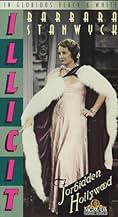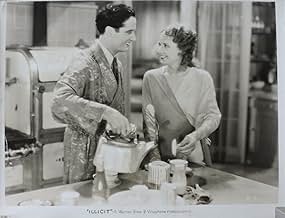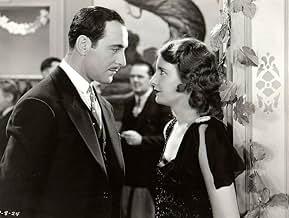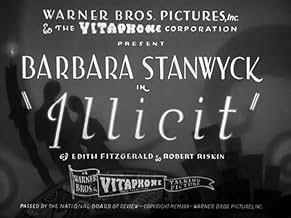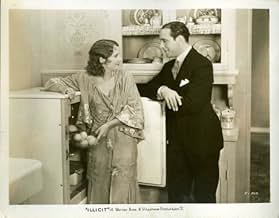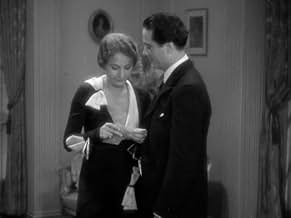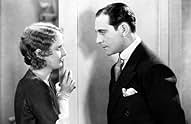IMDb-BEWERTUNG
6,1/10
1250
IHRE BEWERTUNG
Füge eine Handlung in deiner Sprache hinzuA young couple lives together out of wedlock, but they find that they're ahead of their time.A young couple lives together out of wedlock, but they find that they're ahead of their time.A young couple lives together out of wedlock, but they find that they're ahead of their time.
- Regie
- Drehbuch
- Hauptbesetzung
- Auszeichnungen
- 2 wins total
Hazel Howell
- Girl at the Bridal Shower
- (Nicht genannt)
Lucille Ward
- Susan - Anne's Maid
- (Nicht genannt)
Barbara Weeks
- Girl at the Bridal Shower
- (Nicht genannt)
Empfohlene Bewertungen
Am somebody that doesn't mind in any way melodrama, and there are many great ones from the classic film era (name from the 40s and 50s), as long as the film in question is done well. The story sounded really good on paper, even if it is melodramatic personified, and have always loved Barbars Stanwyck as an actress. When it came to melodrama during the "classic film" era, she was one of the greats when it came to actresses, Joan Crawford was another good example.
'Illicit', a very early film for Stanwyck, has been inevitably compared to its "remake" made two years later 'Ex-Lady'. It is not very often where there has been personal preferences for remakes over their originals (David Cronenberg's 'The Fly', from personal opinion, is one of the finest examples of preferring the remake over the original), but to me 'Ex-Lady' is the better film. Found it to be wittier, more daring, that it didn't take itself as seriously and that it has held up better. Am not saying by any stretch that 'Illicit' is a bad film, it isn't and it is definitely worth a look if only once perhaps but that is dependent on one's taste. It is namely to be seen if you want to see Stanwyck in an early role pre-stardom and if you want to see every film of hers in existence.
There are good things here. It is nicely photographed and the period detail in all senses is truly opulent. Absolutely love Stanwyck's clothes and she looks great in them. There are some amusing and moving moments.
Most of my mixed feelings rating though is for the acting, which, excepting a bland and quite stiff James Rennie in a nothing role, is very good. Stanwyck is wonderful with all the things that made her a great actress at her peak emerging here and the main reason to see 'Illicit' (will confess to having to give it less than a 5 if she wasn't as good as she was). Charles Butterworth is the other standout and is an amusing presence, and Joan Blondell is always worth watching. Ricardo Cortez is fine too.
Unfortunately, 'Illicit' comes over as very creaky and stage bound today. Or at least that's my perspective. The pace can be quite dreary and the drama that the quite thin story has feels too much of a very over-heated (a danger with melodrama) filmed play. 'Illicit' has more of a serious tone compared to 'Ex-Lady', so serious that it comes over as a little too glum in places. The sound is quite primitive and has an awkward flow at times.
Did find 'Ex-Lady' (really sorry for the comparison) to be better scripted, just preferred the wittier tone and the tauter pace of it and also found it more daring as said. Anything that may have shocked in 'Illicit' back then is reasonably tame now, whereas you could see much better how 'Ex-Lady' was ahead of its time. Although the acting is good, as said Rennie fails to make much of an impression and a large part of it is down to that his character is very sketchy.
All in all, worth a look but a bit of an oddity. 5/10
'Illicit', a very early film for Stanwyck, has been inevitably compared to its "remake" made two years later 'Ex-Lady'. It is not very often where there has been personal preferences for remakes over their originals (David Cronenberg's 'The Fly', from personal opinion, is one of the finest examples of preferring the remake over the original), but to me 'Ex-Lady' is the better film. Found it to be wittier, more daring, that it didn't take itself as seriously and that it has held up better. Am not saying by any stretch that 'Illicit' is a bad film, it isn't and it is definitely worth a look if only once perhaps but that is dependent on one's taste. It is namely to be seen if you want to see Stanwyck in an early role pre-stardom and if you want to see every film of hers in existence.
There are good things here. It is nicely photographed and the period detail in all senses is truly opulent. Absolutely love Stanwyck's clothes and she looks great in them. There are some amusing and moving moments.
Most of my mixed feelings rating though is for the acting, which, excepting a bland and quite stiff James Rennie in a nothing role, is very good. Stanwyck is wonderful with all the things that made her a great actress at her peak emerging here and the main reason to see 'Illicit' (will confess to having to give it less than a 5 if she wasn't as good as she was). Charles Butterworth is the other standout and is an amusing presence, and Joan Blondell is always worth watching. Ricardo Cortez is fine too.
Unfortunately, 'Illicit' comes over as very creaky and stage bound today. Or at least that's my perspective. The pace can be quite dreary and the drama that the quite thin story has feels too much of a very over-heated (a danger with melodrama) filmed play. 'Illicit' has more of a serious tone compared to 'Ex-Lady', so serious that it comes over as a little too glum in places. The sound is quite primitive and has an awkward flow at times.
Did find 'Ex-Lady' (really sorry for the comparison) to be better scripted, just preferred the wittier tone and the tauter pace of it and also found it more daring as said. Anything that may have shocked in 'Illicit' back then is reasonably tame now, whereas you could see much better how 'Ex-Lady' was ahead of its time. Although the acting is good, as said Rennie fails to make much of an impression and a large part of it is down to that his character is very sketchy.
All in all, worth a look but a bit of an oddity. 5/10
Barbara Stanwyck and James Rennie are ultra-modern 1930s lovers who shun conventional trappings such as marriage. She is afraid that marriage will kill the romance. Who has not had these fears? He is eternally patient, but his father maneuvers her into a commitment. Their marriage stumbles (whose hasn't) and the ex-girlfriend and ex-boyfriend enter the scene. Soon this thoroughly modern couple are acting like typical married folk and Barbara declares that the marriage has indeed killed the love. Stanwyck exhibits skills as an actress that will make her famous in better films later. Claude Gillingwater's portrayal of the father is excellent and serve as a good role model. Charles Butterworth (the faithful friend) was really quite a wit and succeeds in stealing a scene or two. I can overlook any technical flaws in the movie because I think that the central issues are still relevant today. Who has to compromise more in a marriage? The husband or the wife? Will each of the lovers do what is necessary to save the marriage when they know they have problems? All is not revealed until the final scene whose outcome is by no means certain. Good movie, not a great one, but good entertainment for a couple that talk to each other. I say watch it (if you can find it) and see if this pre-Code movie does not warrant your appreciation and was worth your time.
The best part of this rather boring gabfest is getting to see ladies high-fashion outfits, circa 1930. Some of them are real doozies. Stanwyck gets more than her share of slinky finery as a rich guy's paramour. Actually, the movie's premise is a significant one—does marriage somehow kill love? Anne (Stanwyck) seems to think so and sometimes acts on the premise. The trouble is that the premise gets drowned out by all the talk from one scene to the next, without let-up. Then too, director Mayo adds nothing to what turns out to be a filmed stage play. To be charitable, his options may have been cramped by the newness of movie sound equipment.
Pre-Code liberties are evident in the first few scenes where Anne, in a clinging negligee, and Dick (Rennie) discuss whether to marry or to continue living in sin. After that, the screenplay settles into more conventional marital mix-ups. But at least Stanwyck shines, showing why she was slated for bigger and better things. In fact, she's almost girlish, a really long way from the femme fatale of Double Indemnity (1944). Too bad she doesn't have more scenes with that other Warner's personality girl, Joan Blondell (Duckie). Anyway, I found the movie considerably less than I expected.
Pre-Code liberties are evident in the first few scenes where Anne, in a clinging negligee, and Dick (Rennie) discuss whether to marry or to continue living in sin. After that, the screenplay settles into more conventional marital mix-ups. But at least Stanwyck shines, showing why she was slated for bigger and better things. In fact, she's almost girlish, a really long way from the femme fatale of Double Indemnity (1944). Too bad she doesn't have more scenes with that other Warner's personality girl, Joan Blondell (Duckie). Anyway, I found the movie considerably less than I expected.
Prohibition; scorned women, that was the early 30's. This was before the "decency" rules came into effect. Avant garde is the only way to describe this. Dated, yes. But very descriptive of the times. Only Stanwyck could do this well. Her strength and sensitivity are evident in every frame. This is a history lesson of the times and traditions that existed way back when!
In 1931, Stanwyck was still a young girl, with her LONG hair, child-like innocent manner, and round kid face. As Anne Vincent, she wants to stay single and happy, while her beau Dick (James Rennie) wants to get married. Along for fun is Charles Butterworth as George, Dick's sidekick. He tells the couple that they have been discovered, and totters off, for more drinks... Ricardo Cortez is also here as the ex-boyfriend Baines to stir things up; Stanwyck and Cortez had worked together on three films together in the 1930s. Look for a 25 year old Joan Blondell as Helen Childers, Anne's friend, in one of her early roles. Will things stay the same if they get married? That's the big question. Kind of a statement of the times, and even more so in a couple years when the production code will keep everything on the up and up, even when they aren't. This was Darryl Zanuck's 12th film as producer. Towards the middle of the version shown on Turner Classics, there are scratches or wear marks on the right side of the screen, not surprising for such an old film. Interesting to watch, but no big surprises.
Wusstest du schon
- WissenswertesOn the phone, Dick and Anne tease Duckie that they can't agree on which vacuum cleaner to buy, a Peerless or a General Electric. The joke here appears to be that Peerless was an old maker of hand-pump vacuums, never electric ones.
- Patzer(at around 5 mins) As Dick and Anne are walking out of the kitchen, a moving shadow of the boom microphone is visible on the wall to the left.
- Zitate
Richard 'Dick' Ives II: Dad, what would you do with a girl like that?
Richard Ives Sr.: I'd grab her any way she'd have me.
- VerbindungenFeatured in Kino Lust: The Temptations of Eve (1996)
- SoundtracksMaybe It's Love
(1930) (uncredited)
Music by George W. Meyer
Lyrics by Sidney D. Mitchell and Archie Gottler
Whistled by James Rennie
Hummed and sung by Barbara Stanwyck
Top-Auswahl
Melde dich zum Bewerten an und greife auf die Watchlist für personalisierte Empfehlungen zu.
- How long is Illicit?Powered by Alexa
Details
- Erscheinungsdatum
- Herkunftsland
- Sprache
- Auch bekannt als
- Lo ilícito
- Drehorte
- Produktionsfirma
- Weitere beteiligte Unternehmen bei IMDbPro anzeigen
Box Office
- Budget
- 249.000 $ (geschätzt)
- Laufzeit1 Stunde 19 Minuten
- Farbe
Zu dieser Seite beitragen
Bearbeitung vorschlagen oder fehlenden Inhalt hinzufügen


